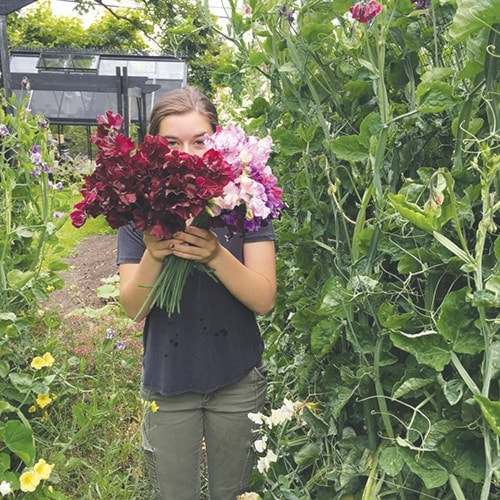In a recent column, I dropped in a note about sweet peas that a reader in Saanich pounced on: is it really time to plant sweet peas? Given she’s English I was surprised she didn’t know that yes, now is the time, my odd assumption being that anyone hailing from that fine country would at birth be a) able to grow them and b) be able to spell posy. So for that friendly reader and those of you still wondering how to grow the most divine of flowers, here is how I do it.
1. I start early. Namely, the year before, at the end of October with one sowing I overwinter in the greenhouse. Some of these babies I have already put out (under cover) in the garden. I sow again in January and again in late February/early March, which somewhat allows me to stagger my harvest.
To start, I soak the seeds overnight in water indoors. After twenty-four hours I drain the seeds onto paper towel and place them in a small dish, tucking the towel under and over the seeds. I keep them moist, at room temperature, until they sprout (a little white radicle curls out from the seed). Only then do I plant the germinated seeds in soil.
2. For pots, I use root trainers, which are elongated. If you can’t find them, a regular tall pot will do (some people use toilet paper rolls packed tightly in a large cake pan). Keep your sweet pea pots indoors/cozy until the plant sends up a green shoot, and then immediately move them to a bright and cool location. The goal here is to avoid a tall sappy stem (from too much heat and not enough light) while still encouraging growth. If you do not have a bright and cool location, put your plants outside in a sheltered location during the day and bring them into a cool room in the house at night.
3. A couple of weeks later, when the plant has three sets of leaves (or the nubby beginnings of leaves), pinch out the growing tip. Snip it right off. This will encourage branching, giving you more blooms.
4. Prep a site that would qualify as at least ‘part-to-full sun.’ Ensure there’s some airflow as sweet peas can suffer from mildew. Amend the soil with compost and a complete organic fertilizer. Hammer in some t-posts or set up your bamboo tepee or trellis or whatever you plan to grow the peas up. Mine reach close to seven feet in a season, so I ensure my posts are solidly driven into the ground before I attach netting; I use zip ties to fasten.
5. When the weather settles in late March or early April, plant ‘hardened-off’ sweet peas in the garden, watering them in. I plant branched baby sweet peas about 6 inches apart, staggering them in rows along both sides of the netting. Keep them watered, but not soaked, through to July. Feed weekly with fish/seaweed emulsion.
6. Keep flowers picked. As soon as a flower runs to seed the plant’s work is done and it will halt blooming.
Growing great sweet peas starts with good seed. I order mine from Owl’s Acres in the UK and Floret in the US. If you want to grab some this weekend locally, look for Renee’s Garden Seeds at Dig This. Read the label. Sweet peas come in dwarf varieties suitable for pots and also vary tremendously in stem length and size. Generally the ‘Spencer’ types are large-flowered, long-stemmed and ruffled, but some scent has been traded off for bloom size. The sweetest smelling sweet peas are often classed as ‘Heirloom’ and tend to be smaller in size.
Christin Geall is an avid Oak Bay gardener and a creative non-fiction writing instructor with the University of Victoria.
